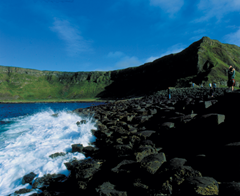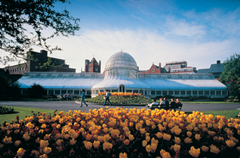Draft tourism strategy
 Tourism has been hit hard by the global financial crisis but a new strategy has been drawn up to improve the situation by 2020. Emma Blee analyses the plans.
Tourism has been hit hard by the global financial crisis but a new strategy has been drawn up to improve the situation by 2020. Emma Blee analyses the plans.
“The development of Northern Ireland as a tourism destination is about more than economic development,” states Arlene Foster.
While there was significant growth in tourism between 1997 and 2007, this has now paused. However, the new draft tourism strategy is aiming to “create the new Northern Ireland experience and get it on everyone’s destination wish list”.
The strategy recognises that tourism targets should be ambitious, but expressed a desire “to protect the qualities that make Northern Ireland special and unique”.
The consultation period for the draft tourism strategy ended in May 2010. Asked why it had still not been published, a DETI spokeswoman said the strategy “was always due to come into effect on 1
April 2011 and this has not changed”. She added that it is currently awaiting clearance by the Executive. The main aim is to double the income the province currently earns from tourism by 2020. This will be achieved by:
• increasing visitors from 3.2 million in 2009 to 4.5 million by 2020;
• increasing earnings for tourism from £536 million (2010 forecast figure) to £1 billion by 2020.
One of the key priorities is working with people who live in Ireland to develop a “unique” visitor experience and a high- quality professional industry.
Boosting tourism
Attracting more visitors could be made easier by developing signature projects, making better use of natural resources such as forest parks and reviewing trading hours. Flexibility in facilitative events (e.g. closing streets, issuing licences) could also help.
Promotion of tourism in general could help to bring new visitors and “to welcome back visitors to see a place that is confidently moving on”. Investing in products and places is also important for residents and future visitors.
A partnership between industry and government is vital to ensure that targets are met. The strategy recommends that tourism area plans should be put in place and local councils will “play a pivotal role” in working alongside the private sector to develop and implement the plans.
 Investing in development is essential. The strategy sets out goals in short term, such as developing the signature projects, creating a conference and exhibition centre in Belfast and developing a year- round events programme. Medium-term actions include improving the use of local food, drink and products, improving the image of the tourism industry and identifying talent.
Investing in development is essential. The strategy sets out goals in short term, such as developing the signature projects, creating a conference and exhibition centre in Belfast and developing a year- round events programme. Medium-term actions include improving the use of local food, drink and products, improving the image of the tourism industry and identifying talent.
Targeted marketing will play a major role in boosting tourism. Priority market segments include city breaks, culture seekers, special interest breaks such as music, golf and walking, as well as business visitors. However, new market segments should also be exploited e.g. food, well-being, green travel.
The document suggests that tourism could also be enhanced by:
• Progressively accelerating spend by visitors;
• Targeting specific markets and market segments;
• Supporting growth in indigenous high quality businesses; and
• Being ‘visitor inspired’ in all actions across government.
In 2008 and 2009 there were shifts in travel patterns, with less business travel and more people spending their holidays at home. However, the document predicts that the global economy will soon start to pick up and should have recovered in 2010.
It does recognise, though, that there will be a “harsh business environment” during the early years of the strategy. Due to this, there will be a review of targets in 2014 to ensure that the aims are within reach.
Speaking about the goals, Foster commented: “Competition for visitors is intense but we have much to offer. The strategy sets challenging targets, but I have confidence in the places and people of Northern Ireland and their ability to deliver.”
Looking ahead
The strategy describes the Northern Ireland Executive as “the champion of tourism”. Discussions have been held with all government departments, and key areas for action have been highlighted for each of these.
There is also a leadership role for the tourism industry. The strategy reads: “The industry needs to organise itself to speak
with one voice, to form a professional approach to delivering value while driving up spending and to participate fully in the development of a more skilled and professional workforce.”
Looking forward to 2020, the document states that priorities have been designed to bring about a “transformation of the visitor experience”. Economic benefits could include 12,000 new jobs, career pathways for young people, development in rural areas, as well as market towns and cities, and new markets for local produce and products.
However, it will “only succeed in creating the new Northern Ireland experience with the help of the people of Northern Ireland”.
| 2011 | 2012 | 2013 | 2014 |
| Lyric theatre | Celebration of NI – This is NI | Belfast rapid transport system | Conference and exhibition centre |
| The MAC | Giant’s Causeway visitor experience | Ebrington/River Foyle regeneration | |
| London Olympics | Public Record Office for Northern Ireland | Links golf resort | |
| Museum of Free Derry | National park * | ||
| Titanic visitor experience | |||
| UK City of Culture | |||
| World Fire and Police Games | |||





